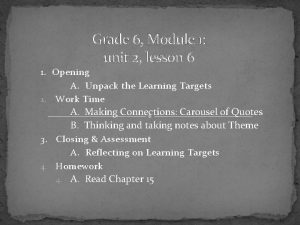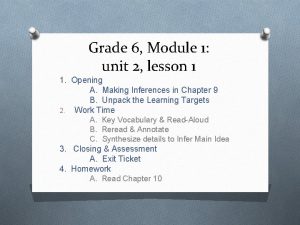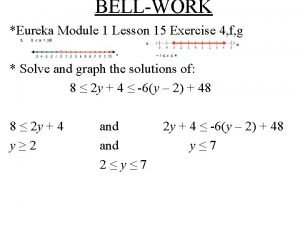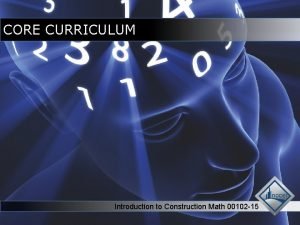MVP Module 1 Lesson 4 MVP NC Math





















- Slides: 21

MVP Module 1 Lesson 4 MVP NC Math 2

Warm-Up Pre. K-12 Mathematics

Lesson Essential Question What does it mean to say that a figure is symmetrical? Pre. K-12 Mathematics

Lesson 4: Symmetries of Quadrilaterals A Develop Understanding Task Pre. K-12 Mathematics

A line that reflects a figure onto itself is called a line of symmetry. A figure that can be carried onto itself by a rotation is said to have rotational symmetry. Every four-sided polygon is a quadrilateral. Some quadrilaterals have additional properties and are given special names like squares, parallelograms and rhombuses. A diagonal of a quadrilateral is formed when opposite vertices are connected by a line segment. Some quadrilaterals are symmetric about their diagonals. Some are symmetric about other lines. In this task you will use rigid motion transformations to explore line symmetry and rotational symmetry in various types of quadrilaterals.

For each of the following quadrilaterals you are going to try to answer the question, “Is it possible to reflect or rotate this quadrilateral onto itself? ” As you experiment with each quadrilateral, record your findings in the following chart. Be as specific as possible with your descriptions.


A trapezoid is a quadrilateral with one pair of opposite sides parallel. Is it possible to reflect or rotate a trapezoid onto itself? Draw a trapezoid based on this definition. Then see if you can find: • any lines of symmetry, or • any centers of rotational symmetry, that will carry the trapezoid you drew onto itself.

If you were unable to find a line of symmetry or a center of rotational symmetry for your trapezoid, see if you can sketch a different trapezoid that might possess some type of symmetry. Pre. K-12 Mathematics

Pre. K-12 Mathematics

Pre. K-12 Mathematics

READY? Topic: Defining and naming polygons Pre. K-12 Mathematics

1. Identify which figure is a polygon. Then explain why one of the figures is not a polygon. Figure 1 Figure 2 Pre. K-12 Mathematics

2. Fill in the names of each type of polygon based on the number of sides the polygon has. Pre. K-12 Mathematics

SET Topic: Kites, Lines of symmetry and diagonals

3. One quadrilateral with special attributes is a kite. Write the geometric definition of a kite. 4. Draw all of the lines of reflective symmetry on the kite. 5. Draw all of the diagonals on the kite.

6. List all of the rotational symmetry for a kite. 7. Are lines of symmetry also diagonals for any given polygon? Explain. 8. Are all diagonals also lines of symmetry for any given polygon? Explain.

9. Which quadrilaterals have diagonals that are not lines of symmetry? Name some and draw them. 10. Do parallelograms have diagonals that are lines of symmetry? If so, draw and explain. If not draw and explain.

GO! Topic: Writing equations for parallel and perpendicular lines.


EXIT TICKET Which quadrilateral is the most symmetrical? Why?
 Mvp math 1
Mvp math 1 Mvp math 2
Mvp math 2 Grade 6, module 1: unit 2 answer key
Grade 6, module 1: unit 2 answer key Grade 6 module
Grade 6 module Eureka math algebra 1 module 1 lesson 15
Eureka math algebra 1 module 1 lesson 15 C device module module 1
C device module module 1 Zappos mvp
Zappos mvp Mvp minimum viable product
Mvp minimum viable product Microsoft mvp certification
Microsoft mvp certification Azure vm ssd
Azure vm ssd Bcgsoft 사용법
Bcgsoft 사용법 Mvp surface sampling device
Mvp surface sampling device Mvp
Mvp Minimum viable product powerpoint template
Minimum viable product powerpoint template Minimum viable product template excel
Minimum viable product template excel Mvp corect ltd
Mvp corect ltd Cqik1
Cqik1 Mvp pilot
Mvp pilot Module 00102-15 introduction to construction math answers
Module 00102-15 introduction to construction math answers Ratio in business mathematics
Ratio in business mathematics Eureka math algebra 1 module 4
Eureka math algebra 1 module 4 Eureka math 3rd grade module 7
Eureka math 3rd grade module 7








































